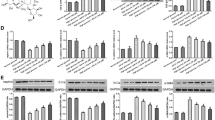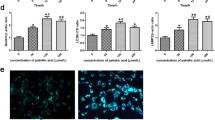Abstract
Autophagy is a cellular pathway involved in degradation of damaged organelles and proteins in order to keep cellular homeostasis. It plays vital role in podocytes. Titanium dioxide nanoparticles (nano-TiO2) are known to induce autophagy in cells, but little has been reported about the mechanism of this process in podocytes and the role of autophagy in podocyte death. In the present study, we examined how nano-TiO2 induced authophagy. Besides that, whether autophagy could protect podocytes from the damage induced by nano-TiO2 and its mechanism was also investigated. Western blot assay and acridine orange staining presented that nano-TiO2 significantly enhanced autophagy flux in podocytes. In addition, AMP-activated protein kinase (AMPK) and mammalian target of rapamycin (mTOR) were involved in such process. 3-(4,5-Dimethylthiazol-2-yl)-2,5-diphenyltetrazolium bromide (MTT) assay indicated that upregulated level of autophagy induced by rapamycin in high concentration nano-TiO2-treated podocytes could significantly reduce the level of oxidative stress and alleviate podocyte death. Downregulating the level of autophagy with 3-methyladenine had the opposite effects. These findings indicate that nano-TiO2 induces autophagy through activating AMPK to inhibit mTOR in podocytes, and such autophagy plays a protecting role against oxidative stress on the cell proliferation. Changing autophagy level may become a new treatment strategy to relieve the damage induced by nano-TiO2 in podocytes.






Similar content being viewed by others
References
Aziz HOA, Awaad A. Titanium dioxide (TiO 2) nanoparticles induced apoptosis of splenocytes in adult male albino rat and the protective role of milk thistle seeds extract. Int J. 2014;2:732–46.
Bruno ME, Sittner M, Cabrini RL, Guglielmotti MB, Olmedo DG, Tasat DR. In vitro age dependent response of macrophages to micro and nano titanium dioxide particles. J Biomed Mater Res A. 2015;103:471–8.
Chen Y, Azad MB, Gibson SB. Superoxide is the major reactive oxygen species regulating autophagy. Cell Death Differ. 2009;16:1040–52.
Fabian E, Landsiedel R, Lan MH, Wiench K, Wohlleben W, Ravenzwaay BV. Tissue distribution and toxicity of intravenously administered titanium dioxide nanoparticles in rats. Arch Toxicol. 2008;82:151–7.
Fang B, Xiao H. Rapamycin alleviates cisplatin-induced ototoxicity in vivo. Biochem Biophys Res Commun. 2014;448:443–7.
Fu, J., Hui, W., Jing, G., Mei, Y., Wang, R., Zhuo, Y. & Tao, Z. 2016. Rapamycin effectively impedes melamine-induced impairments of cognition and synaptic plasticity in Wistar rats. Mol Neurobiol.:1–14.
Gao J, Zhang X, Yu M, Ren G, Yang Z. Cognitive deficits induced by multi-walled carbon nanotubes via the autophagic pathway. Toxicology. 2015;337:21–9.
Ghiazza M, Alloa E, Oliaro-bosso S, Viola F, Livraghi S, Rembges D, Capomaccio R, Rossi F, Ponti J, Fenoglio I. Inhibition of the ROS-mediated cytotoxicity and genotoxicity of nano-TiO2 toward human keratinocyte cells by iron doping. J Nanopart Res. 2014;16:1–17.
Gui S, Li B, Zhao X, Sheng L, Hong J, Yu X, et al. Renal injury and Nrf2 modulation in mouse kidney following chronic exposure to TiO2 nanoparticles. J Agric Food Chem. 2013;61(37):8959–68.
Gui S, Zhang Z, Lei Z, Cui Y, Liu X, Na L, Sang X, Sun Q, Gao G, Zhe C. Molecular mechanism of kidney injury of mice caused by exposure to titanium dioxide nanoparticles. J Hazard Mater. 2011;195:365–70.
Han SG, Newsome B, Hennig B. Titanium dioxide nanoparticles increase inflammatory responses in vascular endothelial cells. Toxicology. 2013;306:1–8.
Hong F, Hong J, Wang L, Zhou Y, Liu D, Xu B, Yu X, Sheng L. Chronic exposure to nanoparticulate TiO2 causes renal fibrosis involving activation of the Wnt pathway in mouse kidney. J Agric Food Chem. 2015;63:1639–47.
Hong F, Wu N, Ge Y, Zhou Y, Shen T, Qiang Q, et al. Nanosized titanium dioxide resulted in the activation of TGF-β/Smads/p38MAPK pathway in renal inflammation and fibration of mice. J Biomed Mater Res A. 2016;104A(6):1452–61.
Hong J, Wang L, Zhao X, Yu X, Sheng L, Xu B, Liu D, Zhu Y, Long Y, Hong F. Th2 factors may be involved in TiO2 NP-induced hepatic inflammation. J Agric Food Chem. 2014;62:6871–8.
Huang S, Chueh PJ, Lin Y-W, Shih T-S, Chuang S-M. Disturbed mitotic progression and genome segregation are involved in cell transformation mediated by nano-TiO2 long-term exposure. Toxicol Appl Pharmacol. 2009;241:182–94.
Hui W, Na G, Li Z, Zhuo Y, Tao Z. Autophagy alleviates melamine-induced cell death in PC12 cells via decreasing ROS level. Mol Neurobiol. 2015;53:1–12.
Jia F, Sun Z, Yan X, Zhou B, Wang J. Effect of pubertal nano-TiO2 exposure on testosterone synthesis and spermatogenesis in mice. Arch Toxicol. 2014;88:781–8.
Jin CY, Zhu BS, Wang XF, Lu QH. Cytotoxicity of titanium dioxide nanoparticles in mouse fibroblast cells. Chem Res Toxicol. 2008;21:1871–7.
Kansara K, Patel P, Shah D, Shukla RK, Singh S, Kumar A, Dhawan A. TiO2 nanoparticles induce DNA double strand breaks and cell cycle arrest in human alveolar cells. Environ Mol Mutagen. 2015;56:204–17.
Kim J, Kundu M, Viollet B, Guan KL. AMPK and mTOR regulate autophagy through direct phosphorylation of Ulk1. Nat Cell Biol. 2011;13:132–41.
Klionsky DJ. The autophagy connection. Dev Cell. 2010;19:11–2.
Kreyling WG, Semmler M, Erbe F, Mayer P, Takenaka S, Schulz H, Oberdorster G, Ziesenis A. Translocation of ultrafine insoluble iridium particles from lung epithelium to extrapulmonary organs is size dependent but very low. J Toxicol Environ Health A. 2002;65:1513–30.
Lee JW, Park S, Takahashi Y, Wang HG. The association of AMPK with ULK1 regulates autophagy. PLoS One. 2010;5:e15394.
Liu H, Ma L, Zhao J, Liu J, Yan J, Jie R, Hong F. Biochemical toxicity of nano-anatase TiO2 particles in mice. Biol Trace Elem Res. 2009;129:170–80.
Liu S, Xu L, Zhang T, Ren G, Yang Z. Oxidative stress and apoptosis induced by nanosized titanium dioxide in PC12 cells. Toxicology. 2010;267:172–7.
Lopes VR, Loitto V, Audinot J-N, Bayat N, Gutleb AC, Cristobal S. Dose-dependent autophagic effect of titanium dioxide nanoparticles in human HaCaT cells at non-cytotoxic levels. J Nanobiotechnol. 2016;14:1.
Ma X, Wu Y, Jin S, Tian Y, Zhang X, Zhao Y, Yu L, Liang XJ. Gold nanoparticles induce autophagosome accumulation through size-dependent nanoparticle uptake and lysosome impairment. ACS Nano. 2011;5:8629–39.
Maiese, K. Targeting molecules to medicine with mTOR, autophagy and neurodegenerative disorders. Br J Clin Pharmacol. 2015. doi:10.1111/bcp.12804.
Meena R, Kajal K, Paulraj R. Cytotoxic and genotoxic effects of titanium dioxide nanoparticles in testicular cells of male wistar rat. Appl Biochem Biotechnol. 2015a;175:394.
Meena R, Kumar S, Paulraj R. Titanium oxide (TiO2) nanoparticles in induction of apoptosis and inflammatory response in brain. J Nanopart Res. 2015b;17:1–14.
Mizushima N, Yoshimori T, Levine B. Methods in mammalian autophagy research. Cell. 2010;140:313–26.
Mundel P, Reiser J, Zuniga Mejia Borja A, Pavenstadt H, Davidson GR, Kriz W, Zeller R. Rearrangements of the cytoskeleton and cell contacts induce process formation during differentiation of conditionally immortalized mouse podocyte cell lines. Exp Cell Res. 1997;236:248–58.
Qi Z, Yan F, Shi W, Zhang C, Dong W, Zhao Y, Shen J, Ji X, Liu KJ, Luo Y. AKT-related autophagy contributes to the neuroprotective efficacy of hydroxysafflor yellow a against ischemic stroke in rats. Transl Stroke Res. 2014;5:501–9.
Rubinsztein DC, Cuervo AM, Ravikumar B, Sarkar S, Korolchuk V, Kaushik S, Klionsky DJ. In search of an "autophagomometer". Autophagy. 2009;5:585–9.
She C, Zhu LQ, Zhen YF, Wang XD, Dong QR. Activation of AMPK protects against hydrogen peroxide-induced osteoblast apoptosis through autophagy induction and NADPH maintenance: new implications for osteonecrosis treatment? Cell Signal. 2014;26:1–8.
Sheng L, Ze Y, Wang L, Yu X, Hong J, Zhao X, Ze X, Liu D, Xu B, Zhu Y. Mechanisms of TiO2 nanoparticle-induced neuronal apoptosis in rat primary cultured hippocampal neurons. J Biomed Mater Res A. 2015;103:1141–9.
Shi H, Magaye R, Castranova V, Zhao J. Titanium dioxide nanoparticles: a review of current toxicological data. Part Fibre Toxicol. 2013;10:1–33.
Shukla RK, Kumar A, Gurbani D, Pandey AK, Singh S, Dhawan A. TiO2 nanoparticles induce oxidative DNA damage and apoptosis in human liver cells. Nanotoxicology. 2013;7:48–60.
Skocaj M, Filipic M, Petkovic J, Novak S. Titanium dioxide in our everyday life; is it safe? Radiol Oncol. 2011;45:227–47.
Sugiyama M, Takahashi H, Hosono K, Endo H, Kato S, Yoneda K, Nozaki Y, Fujita K, Yoneda M, Wada K. Adiponectin inhibits colorectal cancer cell growth through the AMPK/mTOR pathway. Int J Oncol. 2009;34:339–44.
TuccI P, Porta G, Agostini M, Dinsdale D, Iavicoli I, Cain K, Finazzi-agro A, Melino G, Willis A. Metabolic effects of TiO2 nanoparticles, a common component of sunscreens and cosmetics, on human keratinocytes. Cell Death Dis. 2013;4:e549.
Valant J, Iavicoli I, Drobne D. The importance of a validated standard methodology to define in vitro toxicity of nano-TiO2. Protoplasma. 2012;249:493–502.
Vicencio JM, Ortiz C, Criollo A, Jones AWE, Kepp O, Galluzzi L, Joza N, Vitale I, Morselli E, Tailler M. The inositol 1,4,5-trisphosphate receptor regulates autophagy through its interaction with Beclin 1. Cell death differ. Cell Death Differ. 2009;16:1006–17.
Wang B, Yang Q, Sun YY, Xing YF, Wang YB, Lu XT, et al. Resveratrol-enhanced autophagic flux ameliorates myocardial oxidative stress injury in diabetic mice. J Cell Mol Med. 2014;18(8):1599–1611.
Wang Y, Cui H, Zhou J, Li F, Wang J, Chen M, Liu Q. Cytotoxicity, DNA damage, and apoptosis induced by titanium dioxide nanoparticles in human non-small cell lung cancer A549 cells. Environ Sci Pollut Res. 2015;22:5519–30.
Watanabe R, Fujii H, Shirai T, Saito S, Ishii T, Harigae H. Autophagy plays a protective role as an anti-oxidant system in human T cells and represents a novel strategy for induction of T-cell apoptosis. Eur J Immunol. 2014;44(8):2508–20.
Wei P, Zhang L, Lu Y, Man N, Wen L. C60 (Nd) nanoparticles enhance chemotherapeutic susceptibility of cancer cells by modulation of autophagy. Nanotechnology. 2010;21:495101.
Wu L, Feng Z, Cui S, Hou K, Tang L, Zhou J, Cai G, Xie Y, Hong Q, Fu B. Rapamycin upregulates autophagy by inhibiting the mTOR-ULK1 pathway, resulting in reduced podocyte injury. PLoS One. 2013;8:e63799.
Yamamoto A, Tagawa Y, Yoshimori T, Moriyama Y, Masaki R, Tashiro Y. Bafilomycin A1 prevents maturation of autophagic vacuoles by inhibiting fusion between autophagosomes and lysosomes in rat hepatoma cell line, H-4-II-E cells. Cell Struct Funct. 1998;23:33–42.
Yin J-J, Liu J, Ehrenshaft M, Roberts JE, Fu PP, Mason RP, Zhao B. Phototoxicity of nano titanium dioxides in HaCaT keratinocytes—generation of reactive oxygen species and cell damage. Toxicol Appl Pharmacol. 2012;263:81–8.
Younes NRB, Amara S, Mrad I, Ben-slama I, Jeljeli M, Omri K, El Ghoul J, El Mir L, Rhouma KB, Abdelmelek H. Subacute toxicity of titanium dioxide (TiO2) nanoparticles in male rats: emotional behavior and pathophysiological examination. Environ Sci Pollut Res. 2015;22:8728–37.
Yu KN, Sung JH, Lee S, Kim JE, Kim S, Cho WY, Lee AY, Park SJ, Lim J, Park C. Inhalation of titanium dioxide induces endoplasmic reticulum stress-mediated autophagy and inflammation in mice. Food Chem Toxicol Int J Publ Br Ind Biol Res Assoc. 2015b;85:106–13.
Yu K-N, Chang S-H, Park SJ, Lim J, Lee J, Yoon T-J, Kim J-S, Cho M-H. Titanium dioxide nanoparticles induce endoplasmic reticulum stress-mediated autophagic cell death via mitochondria-associated endoplasmic reticulum membrane disruption in normal lung cells. PLoS One. 2015a;10:e0131208.
Zabirnyk O, Yezhelyev M, Seleverstov O. Nanoparticles as a novel class of autophagy activators[J]. Autophagy. 2007; 3(3):278–81.
Zhang X, Li W, Yang Z. Toxicology of nanosized titanium dioxide: an update. Arch Toxicol. 2015;89:2207–17.
Zhao Y, Howe JL, Yu Z, Leong DT, Chu JJH, Loo JSC, Ng KW. Exposure to titanium dioxide nanoparticles induces autophagy in primary human keratinocytes. Small. 2013;9:387–92.
Acknowledgments
This work was supported by grant from the National Natural Science Foundation of China (31271074, 81571804) and the National Basic Research Program of China (2011CB944003).
Author information
Authors and Affiliations
Corresponding author
Rights and permissions
About this article
Cite this article
Zhang, X., Yin, H., Li, Z. et al. Nano-TiO2 induces autophagy to protect against cell death through antioxidative mechanism in podocytes. Cell Biol Toxicol 32, 513–527 (2016). https://doi.org/10.1007/s10565-016-9352-y
Received:
Accepted:
Published:
Issue Date:
DOI: https://doi.org/10.1007/s10565-016-9352-y




